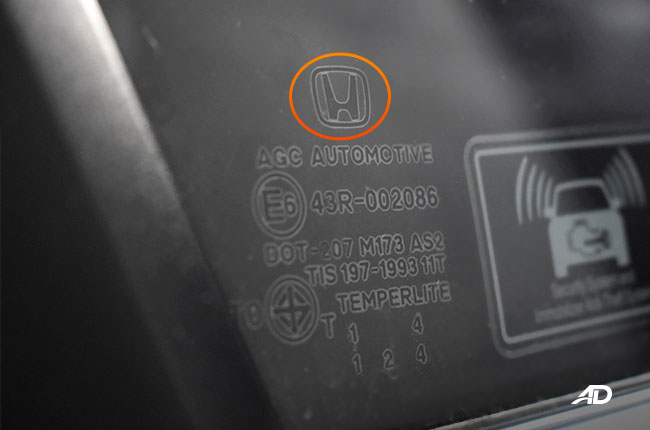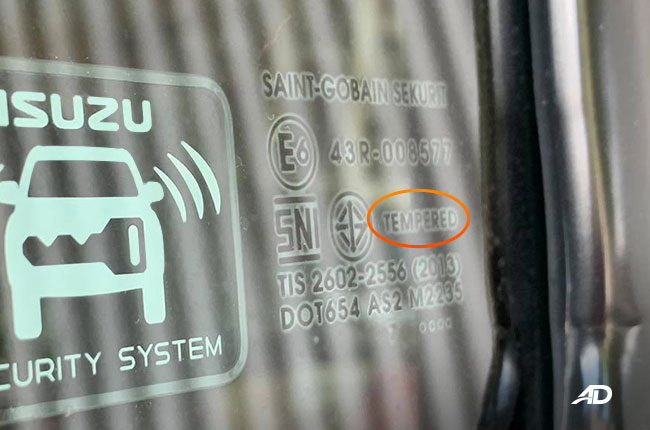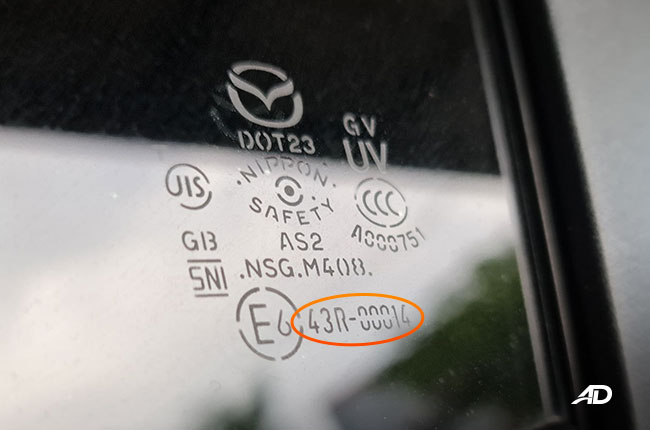
You might have noticed it every time you’ve come across your car, the different labels you see on your windows actually carry meaning. It may not be as important as you think, but it does hold some useful information, plus, killing your curiosity could be fun sometimes. Some labels are pretty straightforward while some are pretty difficult to analyze. That said, here’s a simple guide for you to read and understand the different things that are printed on your car’s window.
Car brand

Starting with the most basic print of all, the car brand. Depending on the manufacturer, some vehicles have it, some don’t. You can usually find this on the bottom portion of your window, it is by far the most noticeable print among the entire cluster.
Automotive glass manufacturer stamp

Next up, is the glass manufacturer stamp. Unlike the car brand print, the automotive glass manufacturer stamp can be sighted on every modern car nowadays. Some examples of brands include Nippon which is a Japanese-based glass manufacturer, Xinyi Glass from China, and Schott from Germany.
Safety standards label

Your car’s window was built meticulously in order to meet the safety standards imposed by other countries. Near the automotive glass, the manufacturer stamp is the safety standard label which denotes the country where it was manufactured. It also means that your car’s glass has solely conformed to the safety standards of that country. Here are the different safety standard labels for you to take note off:
- CCC - China
- KC - Korea
- TISI - Thailand
- DOT - USA
- SABS - South Africa
- JIS - Japan
- AS - Australia
- S - New Zealand
- BS - British
- Inmetro - Brazil
European standards, however, have a different labeling system, with E being its universal letter while each number pertains to its respective country. Also, do take note that even Malaysia (E52) and Thailand (E53) use the E designation which can sometimes be confusing.
- E1 - Germany
- E2 - France
- E3 - Italy
- E4 - Netherlands
- E5 - Sweden
- E6 - Belgium
- E7 - Hungary
- E8 - Czech Republic
- E9 - Spain
- E10 - Serbia
What type of glass is it?

The durability and thickness of your car’s window are usually denoted in roman numeral format. Once it gets higher, the thicker the layer it becomes. Kindly refer to the list below:
- I - Strengthened windshield
- II - Standard multi-layered windshield
- III - Multi-layered windshield with special treatment
- IV - Plastic glass
Other windows of your car except the windshield could be categorized as ‘V’, which means it’s a glass with a light transmission coefficient that is lower than 70%. Moreover, some windows are printed with ‘T’ or ‘TP’ to represent tempered glass and ‘L’ which means laminated glass. Others just have ‘Laminated’ or ‘Tempered’ spelled out as is.
When was it manufactured?

This one’s a bit tricky to analyze, as car brands have different ways of presenting the manufacturing date of the glass. Take this Nippon branded glass as an example.

There are even other methods on how brands laid out their window’s manufacturing dates such as the one above. Some would even require a bit of Math in order to find out when your window was manufactured.
Why are these labels here?

Believe it or not, these labels can be essential at some point. The following information encoded on your car’s window should be helpful when you’re about to find a replacement for it by identifying the brand and what type of glass it is. You can also consult the manufacturing date when you’re planning on purchasing a used window in order to properly assess its quality.
Latest Features
-
How to prepare your car for the Holidays / Featured Article
Here are our handy tips on how to keep you on the road and stress free this holiday season.
-
An all-electric future: The Porsche Macan Electric / Featured Article
Porsche’s Macan goes all-electric; it’s a new beast with an electrified heart, yet unmistakably Porsche in performance and spirit.
-
Which Kia should I buy? / Featured Article
We’re here to help you decide which Kia vehicle is best for you, whether it’s a sedan, crossover, or minivan.
Popular Articles
-
Electric Vehicles in the Philippines for under P1 million
Jerome Tresvalles · Aug 19, 2025
-
Top 3 Cars For Every Lifestyle—What Cars Are Right For You? | Behind a Desk
Caco Tirona · Apr 24, 2024
-
5 Tips to Maximize Fuel Efficiency
Jerome Tresvalles · Sep 09, 2024
-
Five driving habits that are draining your fuel tank
Jerome Tresvalles · Jun 24, 2025
-
Can engine braking harm your engine?
Jerome Tresvalles · Sep 11, 2025
-
Do electric cars even need maintenance?
Jerome Tresvalles · Oct 23, 2024
-
Best vehicles for an active outdoor lifestyle
Shaynah Miranda · Jul 25, 2024
-
How to drive different types of vehicle transmissions
May 23, 2024
-
5 easy ways to keep your car interior clean
Allysa Mae Zulueta · Nov 15, 2021
-
How to survive Metro Manila traffic
Earl Lee · Aug 16, 2022



